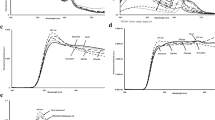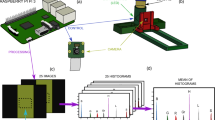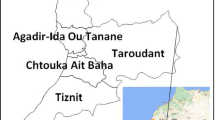Abstract
This study investigates the feasibility of using front face fluorescence (FFFS) and ultraviolet–visible (UV–visible) spectroscopies to authenticate 100 extra virgin argan oil (EVAO) samples from five Moroccan regions (Chtouka, Essaouira, Sidi Ifni, Taroudant, and Tiznit). Additionally, the study aims to identify and predict the percentage of adulteration in pure EVAO samples from these regions using less expensive vegetable oils (such as peanut, walnut, hazelnut, sunflower, grape, rapeseed, sesame, olive, and a mixture of these oils) at varying levels (1, 5, 10, 20, 30, 40 and 50%). By applying principal component analysis and factorial discriminant analysis on emission spectra acquired after excitation wavelengths set at 430 nm, 290 nm, and 270 nm, a perfect discrimination of EVAO samples based on their geographic origin was observed, achieving 100% correct classification; while UV–visible spectra data achieved 98.67% correct classification. Regarding the prediction of purity level of EVAO, partial least square regression applied to FFFS and UV–visible spectra data yielded an excellent prediction of adulteration level, with R2 values of 0.99 for both spectral technics.






Similar content being viewed by others
Data availability
The data that support the findings of this study are available on request from the corresponding author.
References
Msanda F, El Aboudi A, Peltier J-P (2005) Biodiversité et biogéographie de l’arganeraie marocaine. Cah Agric 14:357–364
Hilali M, Charrouf Z, Soulhi AEA et al (2005) Influence of origin and extraction method on argan oil physico-chemical characteristics and composition. J Agric Food Chem 53:2081–2087. https://doi.org/10.1021/jf040290t
Kharbach M, Kamal R, Bousrabat M et al (2017) Characterization and classification of PGI Moroccan argan oils based on their FTIR fingerprints and chemical composition. Chemom Intell Lab Syst 162:182–190. https://doi.org/10.1016/j.chemolab.2017.02.003
Aithammou R, Harrouni C, Aboudlou L et al (2019) Effect of clones, year of harvest and geographical origin of fruits on quality and chemical composition of argan oil. Food Chem 297:124749. https://doi.org/10.1016/j.foodchem.2019.05.024
Kharbach M, Kamal R, Mansouri MA et al (2018) Selected-ion flow-tube mass-spectrometry (SIFT-MS) fingerprinting versus chemical profiling for geographic traceability of Moroccan argan oils. Food Chem 263:8–17. https://doi.org/10.1016/j.foodchem.2018.04.059
Zaroual H, El Hadrami EM, Karoui R (2020) A preliminary study on the potential application of Fourier-transform mid infrared for the evaluation of overall quality and authenticity of Moroccan virgin olive oil. J Sci Food Agric. https://doi.org/10.1002/jsfa.10922
Boughattas F, Vilkova D, Kondratenko E, Karoui R (2020) Targeted and untargeted techniques coupled with chemometric tools for the evaluation of sturgeon (Acipenser gueldenstaedtii) freshness during storage at 4 °C. Food Chem 312:126000. https://doi.org/10.1016/j.foodchem.2019.126000
Karoui DÉ, Pillonel L et al (2004) Determining the geographic origin of Emmental cheeses produced during winter and summer using a technique based on the concatenation of MIR and fluorescence spectroscopic data. Eur Food Res Technol 219:184–189. https://doi.org/10.1007/s00217-004-0936-z
Kharbach M, Kamal R, Marmouzi I et al (2019) Fatty-acid profiling vs UV–visible fingerprints for geographical classification of Moroccan argan oils. Food Control 95:95–105. https://doi.org/10.1016/j.foodcont.2018.07.046
Addou S, Fethi F, Chikri M, Rrhioua A (2016) Detection of argan oil adulteration with olive oil using fluorescence spectroscopy and chemometrics tools. J Mater Environ Sci 7:2689–2698
EEC (2019) EUR-Lex-31991R2568-EN-EUR-Lex
Alamprese C, Casiraghi E (2015) Application of FT-NIR and FT-IR spectroscopy to fish fillet authentication. LWT Food Sci Technol 63:720–725. https://doi.org/10.1016/j.lwt.2015.03.021
Kharbach M, Yu H, Kamal R et al (2021) Talanta new insights into the argan oil categories characterization: chemical descriptors, FTIR fingerprints, and chemometric approaches. Talanta 225:122073. https://doi.org/10.1016/j.talanta.2020.122073
Rahmani M (2005) Composition chimique de l’huile d’argane « vierge ». Agricultures 14:461–465
Mbesse Kongbonga Y, Ghalila H, Majdi Y et al (2015) Investigation of heat-induced degradation of virgin olive oil using front face fluorescence spectroscopy and chemometric analysis. JAOCS J Am Oil Chem Soc 92:1399–1404. https://doi.org/10.1007/s11746-015-2704-6
Issaoui M, Flamini G, Brahmi F et al (2010) Effect of the growing area conditions on differentiation between Chemlali and Chétoui olive oils. Food Chem 119:220–225. https://doi.org/10.1016/j.foodchem.2009.06.012
Zhao Z, Wu X, Liu H (2022) Vision transformer for quality identification of sesame oil with stereoscopic fluorescence spectrum image. LWT 158:113173. https://doi.org/10.1016/j.lwt.2022.113173
Poulli KI, Mousdis GA, Georgiou CA (2009) Monitoring olive oil oxidation under thermal and UV stress through synchronous fluorescence spectroscopy and classical assays. Food Chem 117:499–503. https://doi.org/10.1016/j.foodchem.2009.04.024
Zaroual H, El Hadrami EM, Karoui R (2021) A preliminary study on the potential of front face fluorescence spectroscopy for the discrimination of Moroccan virgin olive oils and the prediction of their quality. Anal Methods 13:345–358. https://doi.org/10.1039/d0ay01746a
Kongbonga YGM, Ghalila H, Onana MB et al (2011) Characterization of vegetable oils by fluorescence spectroscopy. Food Nutr Sci 02:692–699. https://doi.org/10.4236/fns.2011.27095
Rueda A, Samaniego-Sánchez C, Olalla M et al (2016) Combination of analytical and chemometric methods as a useful tool for the characterization of extra virgin argan oil and other edible virgin oils. Role of polyphenols and tocopherols. J AOAC Int 99:489–494. https://doi.org/10.5740/jaoacint.15-0121
Khallouki F, Voggel J, Breuer A et al (2017) Comparison of the major polyphenols in mature argan fruits from two regions of Morocco. Food Chem 221:1034–1040. https://doi.org/10.1016/j.foodchem.2016.11.058
Uncu O, Ozen B (2019) A comparative study of mid-infrared, UV–visible and fluorescence spectroscopy in combination with chemometrics for the detection of adulteration of fresh olive oils with old olive oils. Food Control 105:209–218. https://doi.org/10.1016/j.foodcont.2019.06.013
Li Y, Chen S, Chen H et al (2020) Effect of thermal oxidation on detection of adulteration at low concentrations in extra virgin olive oil: Study based on laser-induced fluorescence spectroscopy combined with KPCA–LDA. Food Chem. https://doi.org/10.1016/j.foodchem.2019.125669
Stokes TD, Foteini M, Brownfield B et al (2018) Feasibility assessment of synchronous fluorescence spectral fusion by application to argan oil for adulteration analysis. Appl Spectrosc 72:432–441. https://doi.org/10.1177/0003702817749232
El OA, Elhamdaoui O, Cheikh A, Zoukeni B (2021) Comparative study of three fi ngerprint analytical approaches based on spectroscopic sensors and chemometrics for the detection and quanti fi cation of argan oil adulteration. J Sci Food Agric. https://doi.org/10.1002/jsfa.11335
Acknowledgements
Ms. EL Haddad is grateful to Erasmus+MIC (Grant no. 1) for its financial support of her Ph.D. during her stay at Artois University.
Author information
Authors and Affiliations
Corresponding author
Ethics declarations
Conflict of interest
The authors declare that they have no known competing financial interests or personal relationships that could have appeared to influence the work reported in this paper.
Compliance with ethical requirements
Not Applicable.
Informed consent
Informed consent was obtained from all individual participants included in the study.
Additional information
Publisher's Note
Springer Nature remains neutral with regard to jurisdictional claims in published maps and institutional affiliations.
Rights and permissions
Springer Nature or its licensor (e.g. a society or other partner) holds exclusive rights to this article under a publishing agreement with the author(s) or other rightsholder(s); author self-archiving of the accepted manuscript version of this article is solely governed by the terms of such publishing agreement and applicable law.
About this article
Cite this article
El Haddad, Y., Filali-Maltouf, A., Belkadi, B. et al. Moroccan extra virgin argan oil authentication by using ultraviolet–visible and front face fluorescence spectroscopies combined with different descriptive and predictive chemometric tools. Eur Food Res Technol 249, 3247–3259 (2023). https://doi.org/10.1007/s00217-023-04364-0
Received:
Accepted:
Published:
Issue Date:
DOI: https://doi.org/10.1007/s00217-023-04364-0




